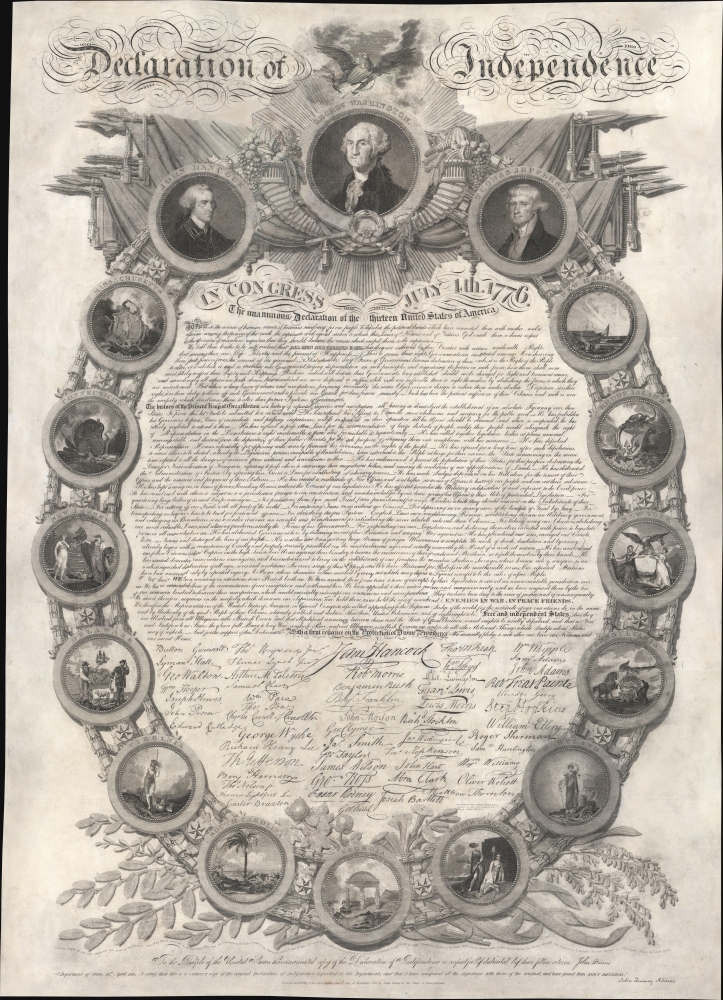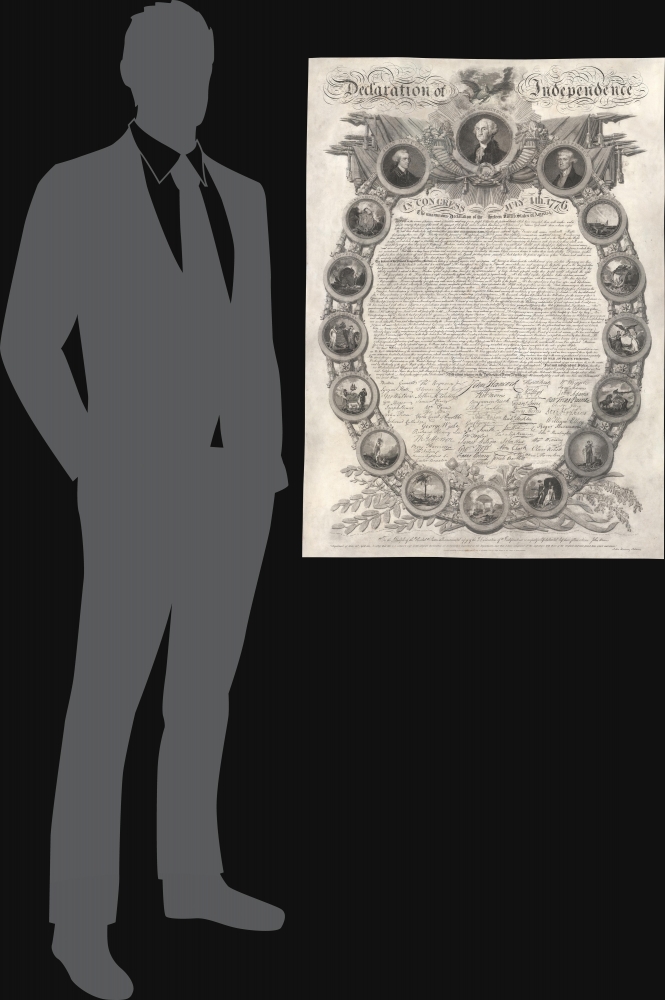Digital Image: 1819 Binns Broadside Declaration of Independence
DeclarationofIndependence-binns-1819_d
Title
1819 (dated) 36 x 26 in (91.44 x 66.04 cm)
Description
FOR THE ORIGINAL ANTIQUE MAP, WITH HISTORICAL ANALYSIS, CLICK HERE.
Digital Map Information
Geographicus maintains an archive of high-resolution rare map scans. We scan our maps at 300 DPI or higher, with newer images being 600 DPI, (either TIFF or JPEG, depending on when the scan was done) which is most cases in suitable for enlargement and printing.
Delivery
Once you purchase our digital scan service, you will receive a download link via email - usually within seconds. Digital orders are delivered as ZIP files, an industry standard file compression protocol that any computer should be able to unpack. Some of our files are very large, and can take some time to download. Most files are saved into your computer's 'Downloads' folder. All delivery is electronic. No physical product is shipped.
Credit and Scope of Use
You can use your digial image any way you want! Our digital images are unrestricted by copyright and can be used, modified, and published freely. The textual description that accompanies the original antique map is not included in the sale of digital images and remains protected by copyright. That said, we put significant care and effort into scanning and editing these maps, and we’d appreciate a credit when possible. Should you wish to credit us, please use the following credit line:
Courtesy of Geographicus Rare Antique Maps (https://www.geographicus.com).
How Large Can I Print?
In general, at 300 DPI, you should at least be able to double the size of the actual image, more so with our 600 DPI images. So, if the original was 10 x 12 inches, you can print at 20 x 24 inches, without quality loss. If your display requirements can accommodate some loss in image quality, you can make it even larger. That being said, no quality of scan will allow you to blow up at 10 x 12 inch map to wall size without significant quality loss. For more information, it is best consult a printer or reprographics specialist.
Refunds
If the high resolution image you ordered is unavailable, we will fully refund your purchase. Otherwise, digital images scans are a service, not a tangible product, and cannot be returned or refunded once the download link is used.
Cartographer S
John Binns (December 22, 1772 - June 16, 1860) was an Irish-American journalist, engraver, radical politician, and publisher. Binns was born in Dublin, Ireland to a wealthy ironmonger, also John Binns. His father died when he was young, and his mother remarried the lawyer George McEntegarte - who proved abusive to both John and his brother Benjamin (1771 - c. 1857). The brothers fled to their grandfather's home in Dublin, where they attended the Sisson Putland Darling's (1737 - 1817) school. John was later apprenticed as a chandler and soaper. As a young man he relocated with his brother Benjamin Binns, to London where they became political radicals with the London Corresponding Society. John, a gifted public speaker, became chairmen of that organization's general committee in 1795. He traveled throughout England preaching Paineite Radicalism and violent revolution. His political leanings caused him to be arrested and imprisoned several times. The ground getting too hot for them in London 1801, the brothers immigrated to the United States, settling in Baltimore. There they joined the deist New York Society of Theophilanthropists, which advocated a freethinking, democratic, republican society. In 1802, he founded a radical left newspaper, the Republican Argus in Northumberland, Pennsylvania. Later, from 1807 to 1829, he published the Philadelphia Democratic Press, then Pennsylvania's leading Democratic newspaper. His political beliefs in included the territorial annexation of Canada and global American imperialism - with the idea being to forcibly spread democracy. Binns is best known for his 1819 issue of a highly decorative ceremonial broadside of the Declaration of Independence. He also published an autobiography in 1854 and died in Philadelphia in 1857. More by this mapmaker...
John Vallance (1770 - June 14, 1823) was a Philadelphia based engraver active in the late 18th and early 19th centuries. Vallance was born in Glasgow, Scotland. Some scholars claim he apprenticed under Philadelphia engraver James Trenchard, but the dates don't work, as Vallance moved to the United States at 21, already an master engraver. At 21, in the year 1791, Vallance moved to Philadelphia and immediately partnered with James Thacakara, his wife's (a Trenchard?) uncle, establishing the imprint of Thackara and Vallance. The firm completed numerous significant cartographic projects, including maps for Andrew Ellicott, John Melish, Henry S. Tanner, and Reading Howell. Vallance later partnered with Henry Schenck Tanner (1786 - May 18, 1858) and Francis Kearney, forming Vallance, Kearney and Co. Vallance, working with Thackara, produced some of the most important early maps of Washington D.C., engraved early Continental Currencies, and worked on Dobson's Encyclopedia. In addition to his cartographic work, Vallance was also one of the founding members of the Philadelphia based Association of Artists in America. Learn More...
James Barton Longacre (August 11, 1794 - January 1, 1869) was an American portraitist and engraver. He was born on a farm in Delaware County, Pennsylvania, the descendent of the early Swedish settler to that region. At 12, Longacre moved to Philadelphia, apprenticing himself at John E. Watson's bookstore. He was nonetheless more inclined towards the arts, and so in 1813, he transferred his apprenticeship to George Murray, principal in the engraving firm Murray, Draper, Fairman and Co. at 47 Sansom Street, Philadelphia. He started his own engraving business in 1819 at 230 Pine Street - his first project being John Binns' spectacular 'Declaration of Independence' broadside where he engraved portraits of George Washington, Thomas Jefferson, and John Hancock. Although regarded as the 'finest engraver in the United States', his business lagged during the Panic 1837, and he was forced into insolvency. For a time he traveled the Midwest as an itinerant bookseller, but in 1844, returned to Philadelphia where he became the 4th chief engraver of the Philadelphia Mint. There he made his mark as the designer of both the Flying Eagle Cent and the Indian Head Cent. He left the position of Chief Engraver in 1851, but remained active designing coinage for the rest of his career. He died suddenly at his home in Philadelphia on January 1, 1869. Learn More...




